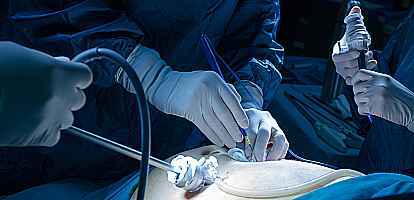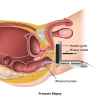Introduction
A prostate biopsy (sampling of tissue with needles) is the definitive method to diagnose prostate cancer. It is not a perfect test, but it remains the only method to do so. This is usually performed after screening tests (PSA, prostate examination, and imaging tests) are done and the patient is deemed to have a reasonable chance of having prostate cancer.
A transperineal (via the skin in the perineum – the area between the scrotum and anus) prostate biopsy is performed for our clinic patients. This is a much safer route as compared to the traditional transrectal route. The rate of severe infection is almost 0% with the transperineal route compared to about 2% - 3% with the transrectal route.
How is it done?
This is an outpatient procedure that takes about 30 minutes. It can be done either under general anaesthesia or intravenous sedation. You will be positioned on your back and a drip will be put into your arm. Sedative medications are then infused through the drip to make you sleepy. Antibiotics are also given this way. Your legs will be lifted and supported (lithotomy position).
A prostate examination with a gloved finger is first done to feel for any palpable abnormalities. A lubricated ultrasound probe is then inserted into the rectum and the prostate is visualised on the ultrasound machine. Further injections of local anaesthetic may be given through the probe into the prostate, to numb the region.
The prostate volume is then measured on the machine, whilst the local anaesthetic is taking effect. A biopsy template is mounted on the operating table and placed on your skin at the perineum, after prepping it with antiseptic. The prostate is mapped using the template and the ultrasound images. A biopsy needle is then inserted into the template and samples will be taken at different parts of the prostate, one at a time via the skin (not the rectum). Multiple samples will be taken, and more samples may be taken if the prostate is large, if this is a repeat biopsy, or if there are suspicious lesions seen on imaging in the prostate. Local anaesthetic is then injected into the skin at the biopsy sites for pain relief.
What are the possible complications?
Bleeding
You are expected to get some blood in the urine, the sperm, and the stools. Most of the time, the bleeding settles down after a few days, but sometimes it can take a few weeks to do so. It is quite uncommon for the bleeding to be severe unless you have a bleeding disorder, or you are on a blood-thinning medication that was not stopped before the biopsy.
Infection
Infection is a possibility too. This can range from a simple bladder infection (symptoms are burning when urinating, smelly urine, frequent need to urinate) to an infection in the blood system (sepsis). Sepsis is very uncommon (close to 0%) with the transperineal route. The symptoms are feeling generally unwell, shakes, chills, and fevers (> 38 degrees Celsius). This usually happens within a few days of the biopsy. If it occurs, you must go to the emergency department for admission into the hospital to get antibiotics treatment through a vein.
Urinary Retention
Some patients can go into urinary retention (cannot pass urine), especially if they have pre-existing prostate-related bladder symptoms. If this happens, a catheter must be placed into the bladder to drain it.
How do I prepare for a prostate biopsy?
If you have a urine infection, you need antibiotic treatment to clear this before the biopsy.
If you are on certain blood-thinning medications (e.g., Aspirin, Warfarin, Plavix, Iscover), you may be asked to withhold them before the biopsy. Most of these medications take at least 5 to 7 days to clear out of your body, so you will need to follow the instructions (about when to stop them) very carefully. Some others (e.g., Eliquis, Xarelto) must be stopped at least 2 days prior. If the medication is not stopped adequately in advance, then the biopsy may be postponed due to the risk of bleeding. After the biopsy, you may be asked to keep withholding the medications for a few more days until the bleeding settles.
Some newer diabetic medications may have to be stopped before the biopsy. Please check with your doctor.
On the day of the biopsy, you must fast (no food or drinks) from 6 hours prior if you are having intravenous sedation or general anaesthesia.
See preparing for surgery, for more instructions.
What happens after the biopsy?
At the end of the procedure, a small dressing will be placed over the skin of the perineum. You will be brought to the recovery area. Once you are able to pass urine, you should be able to go home. If you had sedation or general anaesthesia, you should not drive home.
You should rest well and drink lots of fluids at home. Remember to finish the course of antibiotics. Do light duties as long as there is still some bleeding. Once the bleeding stops, you can resume normal activities. Ask your doctor for instructions on when you can restart any medication that you have stopped prior to the biopsy.
You will be given an appointment to follow up on your results, usually within 2 weeks. If you have any problems, you can contact us, or your family doctor, or go to the emergency department.

